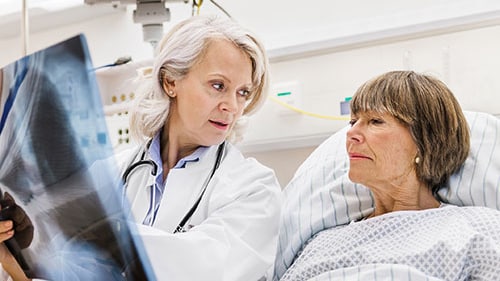Key points
- Legionnaires' disease can't be clinically or radiographically distinguished from pneumonia due to other pathogens.
- Appropriate testing must be performed to make the correct diagnosis and inform treatment decisions.
- The first-line treatment for healthcare-associated or community-acquired pneumonia doesn't always include Legionella-directed antibiotics.
- Ask your patients about possible travel or healthcare exposures.

Indications for Legionnaires' disease testing
For patients with pneumonia, the following indications warrant testing for Legionnaires' disease:
- Outpatient antibiotic failure for community-acquired pneumonia
- Severe pneumonia, in particular illness requiring intensive care
- Presence of an immunocompromising condition
- Overnight travel away from the home during incubation period
- Risk factors and hospitalization with healthcare-associated pneumonia
- Overnight stay in a healthcare facility during incubation period
- Epidemiologic link to a setting with known Legionella concerns
Settings with concerns include those where Legionella has been identified or association with at least one laboratory-confirmed Legionnaires' disease case.
Testing for healthcare-associated Legionnaires' disease is especially important if any of the following are identified in a healthcare facility:
- Healthcare-associated Legionnaires' disease diagnosis in the last year
- Positive environmental tests for Legionella
- Recent changes in water quality that may lead to Legionella growth
Importance of asking about healthcare and travel exposures
The majority of recognized Legionnaires' disease outbreaks are associated with:
Healthcare-associated cases: Timely reporting ensures steps can be taken to protect these highly susceptible populations.
Travel-associated cases: Approximately 10–15% of all reported cases of Legionnaires' disease occur in people who have traveled during their exposure period. Outbreaks among travelers can be difficult to detect because of
- The low attack rate
- The time interval between exposure and symptom onset
- Dispersal of people from the source of the outbreak
- Underdiagnosis of cases
Therefore, collecting and reporting information about overnight travel is important.
Diagnosis
The preferred diagnostic tests for Legionnaires' disease are both of the following paired together:
- Culture or molecular testing of lower respiratory secretions to detect a range of Legionella types
- Legionella urinary antigen test for Legionella pneumophila serogroup 1
Lower respiratory secretions include sputum and bronchoalveolar lavage.
Specimen collection
Best practice is to obtain both a lower respiratory specimen for culture or molecular testing and urine for the urinary antigen test concurrently. Urinary antigen testing typically detects only one type of Legionella, although infections with other types occur.
Lower respiratory specimens should ideally be obtained prior to antibiotic administration, but antibiotic treatment shouldn't be delayed to facilitate this process. Lower respiratory specimen collection can occur after antibiotic administration begins.
Specimens should be stored in accordance with best practice recommendations from the testing laboratory.
Treatment options
Legionnaires' disease
See treatment guidance for
First line treatment doesn't always include Legionella-directed antibiotics (e.g., macrolides and respiratory fluoroquinolones). Obtaining diagnostic testing before antibiotic administration is preferred; however, antibiotic treatment shouldn't be delayed to facilitate this process.
Pontiac fever
Antibiotic treatment shouldn't be prescribed for Pontiac fever. It's a self-limited illness that doesn't benefit from antibiotic treatment. Patients usually recover within 1 week.
- Garrison LE, Kunz JM, Cooley LA, et al. Vital Signs: Deficiencies in environmental control identified in outbreaks of Legionnaires' disease — North America, 2000–2014. MMWR Morb Mortal Wkly Rep. 2016;65(22):576–84.
- Metlay JP, Waterer GW, Long AC, et al. Diagnosis and Treatment of Adults with Community-acquired Pneumonia. An Official Clinical Practice Guideline of the American Thoracic Society and Infectious Diseases Society of America. Am J Respir Crit Care Med. 2019;200(7):e45-67.
- Kalil AC, Metersky ML, Klompas M, et al. Management of Adults with Hospital-acquired and Ventilator-associated Pneumonia: 2016 Clinical Practice Guidelines by the Infectious Diseases Society of America and the American Thoracic Society. Clin Infect Dis. 2016;63(5):e61-111.
